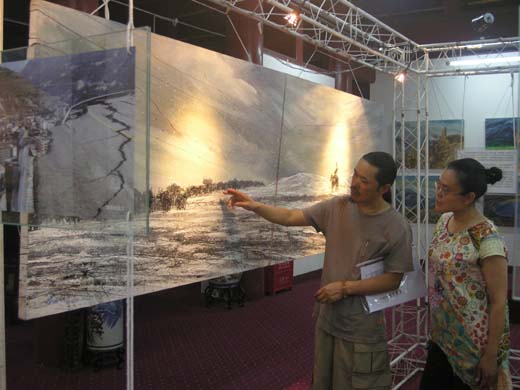Painting exhibition to raise funds for ethnic Qiang people
By Huang Zhiling (www.chinadaily.com.cn)
Updated: 2008-06-08 11:44
Updated: 2008-06-08 11:44
CHENGDU: Visitors to the studio of Yan Jiyuan, a 107-year-old traditional Chinese painter, in a tranquil, wooded Qing Dynasty (1644-1911) courtyard in the Rongcheng Hotel in the center of Chengdu, capital of Sichuan Province, are impressed by a painting exhibition which includes pictures of earthquake-battered scenes.
|
Datang Zhuoma (R) with her husband Yang Ruihong in front of a painting in their painting exhibition being held in Chengdu, Sichuan Province. [Huang Zhiling/chinadaily.com.cn] |
Entitled "29 Paintings after Surviving the Earthquake and Two Artists," the one-week exhibition, which ends on June 11, depict the beautiful scenery of the Aba Tibetan and Qiang Autonomous Prefecture in Sichuan before the earthquake and the unique lifestyle of its ethnic Tibetan and Qiang inhabitants,
Sponsored by the Sichuan Provincial Artists Association, the exhibiton is to raise funds for their owners Datang Zhuoma and her husband Yang Ruihong to help rebuild Qiang people's homes destroyed in the earthquake.
Datang, a 45-year-old teacher in the Department of Art in the Aba Teacher’s College, and 46-year-old Yang , vice-chairman of the Aba Tibetan and Qiang Autonomous Prefecture Artists Association, have braved aftershocks to salvage the 29 paintings from their studios in Wenchuan county, the epicenter of the May 12 earthquake.
But the couple, who are lovers of the Qiang culture, said that they would take half of the earnings from the sales of the paintings worth nearly 900,000 yuan (US$130,435) helping local Qiang people and children immediately after the exhibition is over.
With a history of 3,000 years, Qing people who mainly live on high mountains and deep valleys along the Minjiang River, a tributary in the upper reaches of the Yangtze River in Sichuan, are known for their high blockhouse-shaped residences made of rocks.
Despite no written language, the Qiang people have created a unique culture including the Qiang New Year, embroidery, dance and religion.
Qiang culture suffered a heavy blow in the earthquake, for all the houses in Luobo, Wenchuan’s largest village inhabited by the Qiang people, were toppled in the earthquake, while Beichuan, the country’s only Qiang autonomous county, was razed to the ground. “All the written information about the Qiang New Year, embroidery, dance and religion in Beichuan has been buried in the quake,” said Guo Guiling, an official with the Sichuan Provincial Department of Culture.
When the earthquake struck, Datong and Yang were drinking tea in a Qiang village in Lixian county, 16 km from their home in Wenchuan. They trekked for four hours and a half compared with normally two hours to reach the Aba Teachers’ College in the county seat of Wenchuan to relocate their students. On the way home, Datang took many pictures of the earthquake-battered scenes which are on display in the painting exhibition.
After sending the last students home on May 26, the couple braved aftershocks to enter their studios in a Qiang blockhouse-shaped building which had become dangerous to take out only 29 of their some 300 paintings with the help of four soldiers of the People’s Liberation Army. “In the studios are my earliest paintings done as a teenager and many embroidered works and articles of daily use of the Qiang people I started collecting 15 years ago,” said Datang, whose real name is Tang Ping. A great lover of Tibetan culture, too, Tang, a native of Zhongjiang county in Sichuan, got her present Tibetan name five years from a Tibetan monk.
|
||
|
||
|
|
|
|


